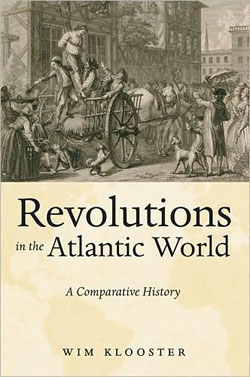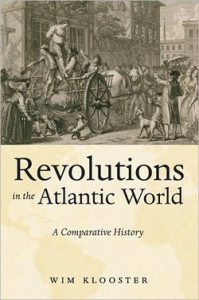The Age of Revolution in an Atlantic Context

In Revolutions in the Atlantic World, historian Wim Klooster finds common ground among four political upheavals of the late eighteenth and early nineteenth centuries and sets each into an Atlantic context. In a brief introductory chapter, the author lays out his objectives: “to present the most significant revolutions of this era on their own terms” (2) and explore threads connecting them. All of these revolutions, Klooster argues, followed a similar trajectory. Financial and political strains undermined the stability of the state, exposing the government’s inability to negotiate with colonial and metropolitan elites. This in turn led to the emergence of strident and impatient voices demanding action and drawing support from the middle ranks of society. As monarchs and those close to them obstructed negotiation, challenges to authority turned violent. Revolutionary leaders recruited their followers from the lower orders of society where lingering resentments over the abuse of privilege had long smoldered. The American, French, Haitian, and Spanish Revolutions, Klooster argues, all followed this path.
In an age of powerful states with extensive colonial systems, the American Revolution demonstrated that it was possible to overthrow an unpopular political structure and replace it with a sovereign nation based on broad republican principles. By 1763, the exorbitant cost of mid-eighteenth-century warfare had left Great Britain burdened with debt, and policy-makers in London saw no reason why the king’s colonial subjects should not shoulder part of the burden. After all, the most recent conflict—the Seven Years’ War—had been fought largely on their behalf. Americans did not see it that way and organized an effective resistance to taxes imposed by the British Parliament. In 1775, American resolve and the failure of the ministry in London to negotiate effectively with colonial elites led to bloodshed and a hardening of positions on both sides. The break with Great Britain (formalized by a declaration of independence in July 1776) precipitated a bloody conflict with atrocities on both sides and the features of civil war. But the scale of violence was modest compared to later revolutions in Europe, the Caribbean, and Spanish America. In Klooster’s book, the great significance of the American Revolution is that it set off a chain of events that led to revolution in France, Saint-Domingue, and Spanish America and the creation of wholly new sovereign states.
Like the American Revolution, the political shakeup in France was rooted in excessive wartime debt (much of it due to French support for the new United States of America in its struggle against Great Britain). In August 1788, with France veering toward bankruptcy, Louis XVI called for a meeting of the Estates General in an effort to stave off financial collapse. The king’s summons provided members of the Third Estate the opportunity to articulate grievances and call for fundamental reforms. Delegates seized the moment and established a national assembly that sharply curtailed the power of the monarchy. Pent-up resentments in the broader population transformed the assembly’s political agenda into a sweeping mass movement against entrenched privilege. The revolution turned sharply violent and demanded the wholesale destruction of the existing social order and the extermination of the enemies of the revolution. Terror at home—seared into popular memory by images of the guillotine at work—and warfare abroad created a nightmarish revolutionary landscape. Revolution became France’s leading export in the 1790s.
The third revolution, an event closely tied to the political crisis in France, places the narrative squarely in an Atlantic World context. The bloody upheaval in the French sugar colony of Saint-Domingue grew out of the contentious relationship between white elites and free people of color, economic reforms following the Seven Years’ War, and the lofty rhetoric of the French Revolution. In 1789, news of revolution in France was welcomed by both whites and free-coloreds on Saint-Domingue, both of which groups chafed under remote and arbitrary French control. But revolutionary rhetoric, with its emphasis on violent action to achieve the “rights of man,” sent a very different signal to the colony’s roughly half million enslaved blacks, who rose against their masters in August 1791 in the Caribbean’s most successful slave rebellion. In the chaos that followed—protracted over a long and bloody decade—Saint-Domingue was scarred by the carnage of civil war (with dizzying shifts in alliances), ill-conceived French attempts to restore order, opportunistic British and Spanish occupations, and all-out race war. Out of this tangle emerged the nation of Haiti, a state that has yet to shake off the legacy of its catastrophic birth.
Wim Klooster’s account of revolution in early nineteenth-century Spanish America connects the collapse of Spanish authority on the American mainland to the Napoleonic Wars. He makes specific reference to the far-reaching consequences of the French occupation of Spain and the temporary removal of King Ferdinand VII from the European political stage. War in Europe set the stage for political crisis, revolution, civil war, and the fragmentation of Spanish America, but “the timing of independence depended as much on developments in the colonies themselves as on those in the mother country” (156). Civil unrest in Spain’s American viceroyalties had deep roots.
Following the Seven Years’ War, there was widespread resistance to reforms initiated by the Madrid government that were meant to tighten links between Spain and its colonies. These tensions pointed to a breakdown in the imperial relationship brought to the surface when Spain was cut off from its New World colonies in the early years of the nineteenth century. Rather than a series of military showdowns with Spain (and, as elsewhere, efforts to reconstruct society to conform to high-minded ideals), the Spanish-America revolutions depicted in Klooster’s book were basically civil wars fought by local plebeians over wealth and power accessible only by a privileged few.
The comparative structure of Revolutions in the Atlantic World encourages readers to look for commonalities and differences on the revolutionary landscapes of British North America, France, Saint-Domingue, and Spanish America. Klooster emphasizes that the revolutions examined here “cannot be understood outside the realm of international politics” and “inter-imperial warfare,” and that events on a large—often Atlantic—stage exposed “enduring social, political, and ethnic inequalities” that had severe unintended consequences (2). Even so, all of these revolutions could have been avoided, and none was guaranteed success. Their precarious nature was exacerbated by divided loyalties, infighting among revolutionary elites, and powerful counter-revolutionary forces. None of the revolutions aimed at creating a democratic society: the main objective was sovereignty, and the character of post-revolutionary rule was typically authoritarian. Klooster points out that the American Revolution is an exception, perhaps because colonial society in British North America had been democratized before the revolution began. However, all of the revolutions examined here bore a common theme of hostility to privilege (at least in their dramatic early stages) and employed an angry rhetoric resentful of tyranny and oppression.
There were, of course, winners and losers. Obvious among the winners were those who survived the bloodletting and went on to secure privilege, wealth, and power in the reconstructed post-revolutionary world. More interesting to Klooster are the losers. Especially striking is the large number of men and women who sacrificed everything for the revolution yet failed to reap the rewards. It is likewise striking how little attention the indigenous peoples of British North America, the French West Indies, and Spanish America received in revolutionary movements that were awash in rhetoric enshrining human dignity and the rights of man. Only in Saint-Domingue was the destruction of slavery high on the agenda of revolutionary leaders, nearly all of whom had been slaves themselves. In post-revolutionary Haiti, however, revolution brought few advantages to the former sugar colony’s black population. And throughout the Atlantic World, the status of women—in spite of the conspicuous role they played in both the American and French revolutions—barely changed.
This book will appeal to students and scholars interested in the Atlantic World as a spawning ground for revolution. Although the author has limited his discussion to revolutions associated with the formation of nation states, he is tempting us to consider failed revolutions as well. One example is the Patriot Revolution in the Dutch Republic (1786-1787). Its mobilization of citizen committees, effective exploitation of the popular press, and emphasis on democratically elected representation are legacies of the American Revolution. In Ireland’s bloody Rising of 1798—an event rooted in both the American and French revolutions—the inner circle of revolutionaries succeeded in gaining French military support in their abortive attempt to overthrow the English and establish an Irish republic. The strength of Klooster’s work lies in its potential to trigger such connections and intersections and thereby broaden our understanding of early-modern revolutionary history.
Wim Klooster’s Revolutions in the Atlantic World: A Comparative History is bold in its implications yet restrained in its assertions. Klooster is careful not to succumb to the temptation of portraying the revolutions in British North America, France, Saint-Domingue, and Spanish America as parallel events. Yet they are intimately connected, and Klooster does not shy away from exploring their commonalities in a broad Atlantic context. This is a balanced, well conceived, and accessible book. Wim Klooster has done a masterful job sorting out the chaotic and kaleidoscopic tumble of events that identify the half-century ending in the mid-1820s as the “Age of Revolution.”
This article originally appeared in issue 11.2 (January, 2011).
Thomas M. Truxes is a clinical assistant professor of Irish Studies and history at New York University. His most recent book, Defying Empire: Trading with the Enemy in Colonial New York, was a finalist for the 2009 Francis Parkman Prize sponsored by the Society of American Historians.
